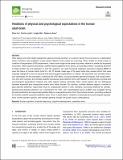| dc.contributor.author | Liu, Shari | |
| dc.contributor.author | Lydic, Kirsten | |
| dc.contributor.author | Mei, Lingjie | |
| dc.contributor.author | Saxe, Rebecca | |
| dc.date.accessioned | 2024-02-22T14:18:13Z | |
| dc.date.available | 2024-02-22T14:18:13Z | |
| dc.date.issued | 2024-02-01 | |
| dc.identifier.issn | 2837-6056 | |
| dc.identifier.uri | https://hdl.handle.net/1721.1/153551 | |
| dc.description.abstract | After seeing one solid object apparently passing through another, or a person taking the long route to a destination when a shortcut was available, human adults classify those events as surprising. When tested on these events in violation-of-expectation (VOE) experiments, infants look longer at the same outcomes, relative to similar but expected outcomes. What cognitive processes underlie these judgments from adults, and perhaps infants’ sustained attention to these events? As one approach to test this question, we used functional magnetic resonance imaging (fMRI) to scan the brains of human adults (total N = 49, 22 female, mean age of 26 years) while they viewed stimuli that were originally designed to test for physical and psychological expectations in infants. We examined non-mutually exclusive candidates for the processes underlying the VOE effect, including domain-general processes, like visual prediction error and curiosity, and domain-specific processes, like prediction error with respect to distinctively physical and psychological expectations (objects are solid; agents behave rationally). Early visual regions did not distinguish between expected and unexpected events from either domain. By contrast, multiple demand regions, involved in goal-directed attention, responded more to unexpected events in both domains, providing evidence for domain-general goal-directed attention as a mechanism for VOE. Left supramarginal gyrus (LSMG) was engaged during physical prediction and responded preferentially to unexpected events from the physical domain, providing evidence for domain-specific physical prediction error. Thus, in adult brains, violations of physical and psychological expectations involve domain-specific, and domain-general, though not purely visual, computations. | en_US |
| dc.language.iso | en_US | |
| dc.publisher | MIT Press | en_US |
| dc.relation.isversionof | 10.1162/imag_a_00068 | en_US |
| dc.rights | Creative Commons Attribution | en_US |
| dc.rights.uri | https://creativecommons.org/licenses/by/4.0/ | en_US |
| dc.source | MIT Press | en_US |
| dc.title | Violations of physical and psychological expectations in the human adult brain | en_US |
| dc.type | Article | en_US |
| dc.identifier.citation | Shari Liu, Kirsten Lydic, Lingjie Mei, Rebecca Saxe; Violations of physical and psychological expectations in the human adult brain. Imaging Neuroscience 2024; 2 1–25. | en_US |
| dc.contributor.department | Massachusetts Institute of Technology. Department of Brain and Cognitive Sciences | |
| dc.eprint.version | Final published version | en_US |
| dc.type.uri | http://purl.org/eprint/type/JournalArticle | en_US |
| eprint.status | http://purl.org/eprint/status/PeerReviewed | en_US |
| dspace.date.submission | 2024-02-21T20:28:35Z | |
| mit.journal.volume | 2 | en_US |
| mit.license | PUBLISHER_CC | |
| mit.metadata.status | Authority Work and Publication Information Needed | en_US |
